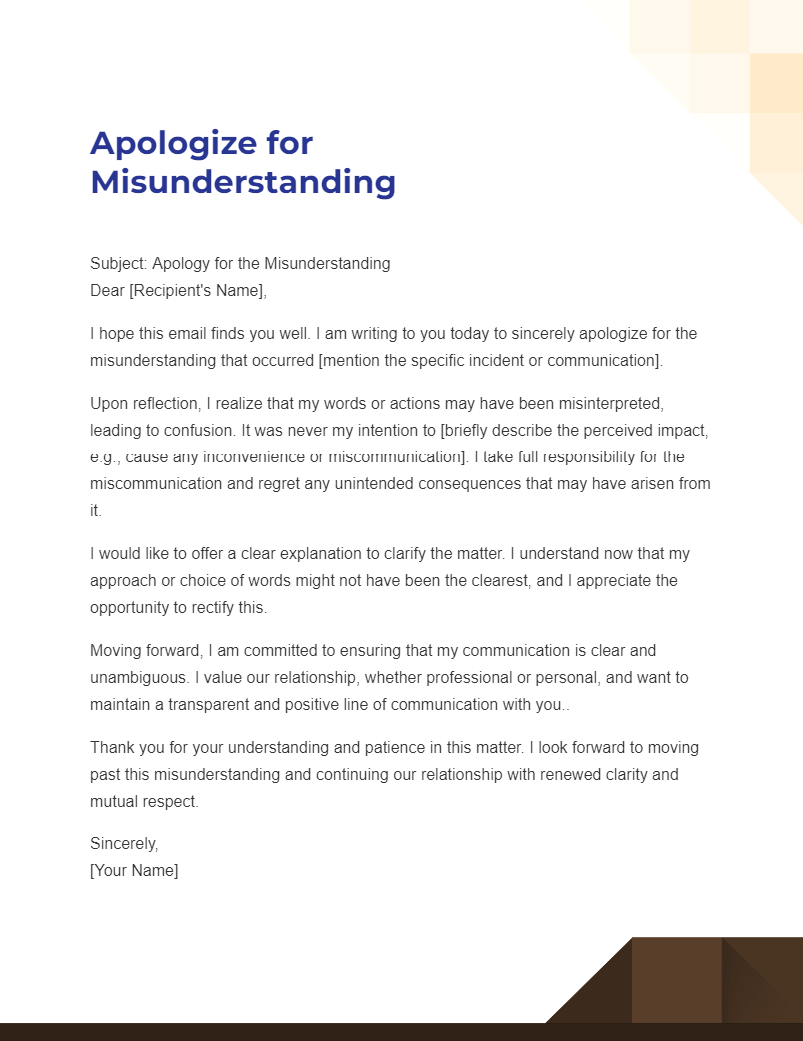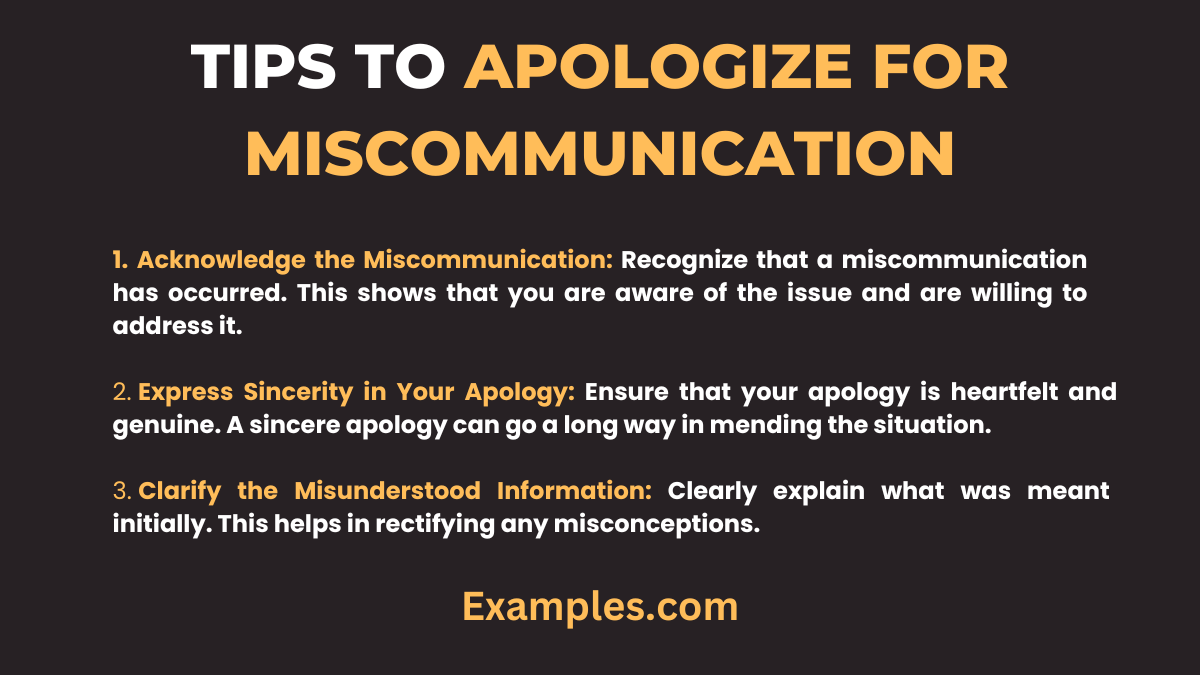How to Apologize for Miscommunication
Miscommunication is an inevitable part of human interaction, but knowing how to effectively apologize can turn misunderstandings into opportunities for growth and learning. Whether it’s in personal relationships, the workplace, or casual interactions, the ability to offer a sincere apology can greatly mitigate the negative effects of miscommunication. This guide will walk you through practical steps, reinforced by miscommunication examples, to help you craft a meaningful apology.
How do you Apologize for misunderstanding in an email?

How to Apologize for Miscommunication at Work?
Apologizing for miscommunication at work involves acknowledging the error, understanding its impact, and taking steps to mend the situation. Here are ten points to guide you:
- Prompt Acknowledgment: As soon as you realize a miscommunication has occurred, acknowledge it. For example, “I’ve noticed that there was a misunderstanding regarding the project timeline.”
- Understand the Impact: Recognize how the miscommunication affected others. Say, “I understand this might have led to confusion in the team.”
- Express Regret: Show that you are genuinely sorry for any inconvenience caused. An example could be, “I apologize for any disruption this has caused.”
- Clear Explanation: Offer a clear and concise explanation of what went wrong. For instance, “There was an error in my communication about the meeting schedule.”
- Propose a Solution: Suggest how to rectify the situation. Example: “I propose a quick team meeting to realign our understandings and expectations.”
- Take Responsibility: Own your part in the miscommunication without blaming others. Say, “I take full responsibility for this oversight.”
- Ensure Future Clarity: Commit to avoiding similar mistakes in the future. For example, “I will double-check all communication for clarity going forward.”
- Seek Feedback: Ask for input from your colleagues on how to improve communication. A line like, “I value your suggestions on how we can communicate more effectively,” can be inclusive.
- Rebuild Trust: Work on actions that rebuild trust with your team. For instance, “I am committed to regaining your trust through transparent and clear communication.”
- Follow-Up: After your apology, follow up to ensure that the issue is resolved and that relationships are mended. Say, “I would like to check back in a week to ensure everything is back on track.”
How to Apologize for Miscommunication to Someone
Apologizing to someone for miscommunication involves empathy, understanding, and a sincere effort to mend the relationship. Here’s how you can do it effectively:
- Direct Approach: Start with a direct apology. For example, “I apologize for the misunderstanding that occurred in our last conversation.”
- Empathize with Their Feelings: Acknowledge how your miscommunication might have affected them. Say, “I can imagine how frustrating it must have been to receive mixed messages.”
- State the Miscommunication: Clearly state what was misunderstood. Example: “I misrepresented the time of our meeting.”
- Accept Responsibility: Take full responsibility for the miscommunication. Avoid excuses. Say, “I should have been more careful in my communication.”
- Offer to Make Amends: Propose a way to rectify the situation. For instance, “I would like to reschedule at a time that’s convenient for you.”
- Ensure Clarity in Future: Commit to clear and precise communication in the future. Example: “I will make sure to double-check my messages for clarity going forward.”
- Listen to Their Side: Give them a chance to express their feelings and concerns. A line like, “I would like to hear your thoughts on this,” can be inviting.
How do you apologize for miscommunication professionally?
Professional apologies for miscommunication require tact, sincerity, and a focus on maintaining professional relationships. Here are ten key points to consider:
- Formal Tone: Use a formal and respectful tone in your apology. Start with, “I would like to formally apologize for the miscommunication that occurred regarding…”
- Immediate Acknowledgment: Acknowledge the miscommunication as soon as it is identified. Say, “I realize now that there was a miscommunication in our last correspondence.”
- Explain Without Excuses: Provide a clear explanation without making excuses. For example, “Due to an oversight, the wrong figures were communicated.”
- Personal Responsibility: Accept personal responsibility for the miscommunication. Say, “I take full responsibility for this error.”
- Impact Assessment: Acknowledge the impact of the miscommunication on the project or task. For example, “I understand this has caused a delay in the project timeline.”
- Propose Corrective Measures: Suggest how you intend to rectify the issue. Example: “I am working on revising the report with the correct figures.”
- Prevent Future Errors: Discuss steps you will take to prevent similar issues in the future. For instance, “I will implement a double-check system for all future communications.”
How to Apologize for Miscommunication to Boss?
Apologizing to your boss for a miscommunication requires a careful approach, emphasizing respect, responsibility, and a commitment to improvement. Here are ten steps to guide you:
- Respectful Start: Begin with a respectful tone. For example, “I would like to express my sincere apologies for the miscommunication that occurred in relation to…”
- Immediate Acknowledgment: Don’t delay in acknowledging the miscommunication. Say, “I have realized that there was a misunderstanding regarding…”
- Clear Explanation: Offer a concise and clear explanation of what went wrong. For instance, “In my email, I inadvertently communicated the wrong deadline.”
- Take Full Responsibility: Accept full responsibility without blaming others. Say, “I understand that this was my mistake and I take full responsibility.”
- Understand the Consequences: Acknowledge the impact your miscommunication had. For example, “I recognize this has caused confusion and possibly delayed our project.”
- Offer Solutions: Propose ways to correct the error. Say, “I have already started working on rectifying this error by…”
- Commit to Improvement: Assure your boss that you will take steps to prevent future miscommunications. For instance, “I will ensure to double-check all critical communications in the future.”
Tips to Apologize for Miscommunication

Miscommunication can occur in various settings, from personal relationships to professional environments. Apologizing effectively for miscommunication is crucial for maintaining healthy interactions. Here are 10 tips for apologizing for miscommunication, each accompanied by an example:
- Acknowledge the Miscommunication: Recognize that a miscommunication has occurred. This shows that you are aware of the issue and are willing to address it.
Example: “I realize now that my message was not clear, and I apologize for any confusion it caused.” - Express Sincerity in Your Apology: Ensure that your apology is heartfelt and genuine. A sincere apology can go a long way in mending the situation.
Example: “I sincerely apologize for the misunderstanding. It was never my intention to create any confusion.” - Clarify the Misunderstood Information: Clearly explain what was meant initially. This helps in rectifying any misconceptions.
Example: “When I mentioned the deadline, I was referring to the initial draft, not the final submission.” - Take Responsibility: Accept responsibility for your part in the miscommunication. This demonstrates maturity and accountability.
Example: “I take full responsibility for not conveying the message more clearly.” - Listen to the Other Person’s Perspective: Give the other person a chance to express how the miscommunication affected them. This shows respect and understanding.
Example: “I’d like to understand how this miscommunication impacted your work.” - Offer a Solution or a Way Forward: Suggest a practical way to resolve any issues caused by the miscommunication.
Example: “To avoid similar issues in the future, I propose we use a shared document for updates.” - Ensure Open and Clear Communication in the Future: Commit to improving communication going forward.
Example: “I will make sure to double-check my emails for clarity in the future.” - Follow Up After the Apology: Check back in to ensure that the issue has been resolved and that there are no lingering hard feelings.
Example: “I wanted to follow up and see if there’s anything else we need to address regarding our last conversation.” - Apologize in Person if Possible: Face-to-face apologies can be more effective than written ones, as they allow for immediate interaction and response.
Example: “Can we meet briefly? I’d like to apologize in person for the email miscommunication.” - Reflect on the Experience to Improve: Use this as a learning opportunity to enhance your communication skills.
Example: “This experience has taught me to be more precise in my communications, and I plan to implement this lesson in my future interactions.”
By following these tips, you can effectively apologize for miscommunication, helping to maintain and improve your relationships, both personally and professionally.
Apologizing for miscommunication is essential for maintaining healthy and productive relationships in various aspects of life. This guide provides key points to consider when crafting your apology, ensuring it is sincere, effective, and conducive to better future communications. Remember, a well-delivered apology can turn a misunderstanding into a stepping stone for improved interaction and understanding.



